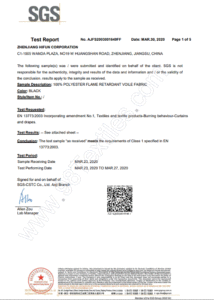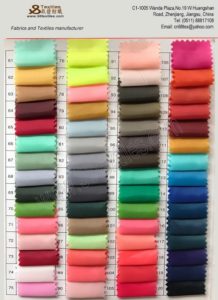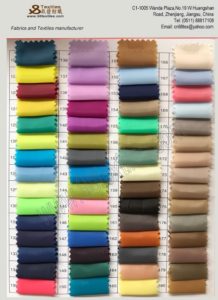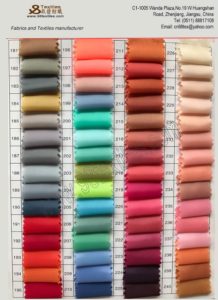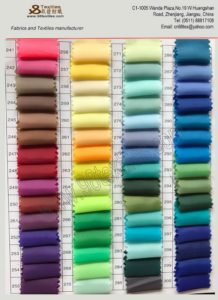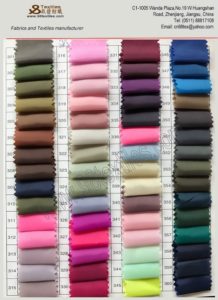Contact Us
One-Stop Service of Various Textiles
Please feel free to contact us for any about of prices, samples, specifications, co-operations, or suggestions.
Request Free Consultation

Get In Touch
Reach Us
- 1#-1005 Wanda Plaza, No.19 W Huangshan Road, Zhenjiang, Jiangsu, China
- Email: cn98tex@yahoo.com
- Tel: +86 511 88817108
- Fax: +86 511 88832289
How can we help you?
Q. 01 Can you seed a sample for reference?
We are glad to send samples for your inspection.
Q. 02 What is your payment?
We usually accept T/T (30% deposit, the balance against the copy of Bill Of Loading);L/C at sight.
Q. 03 How to make an order?
- Sample approval
- Client pays 30% deposit or open LC after receiving our PI;
- Client confirms our sample;
- Production;
- Client approves our shipping sample;
- Arrange shipment;
- Supplier makes necessary documents;
- Client pays the balance payments;
- Supplier sends original documents or telex release the goods.
Q. 04 How to confirm the quality with us before starting to produce?
We can provide samples for you to choose one or more, and then we make the quality according to that.
Or you can send us your samples, and we will make it according to your quality.
Q. 05 How to solve the quality problems after sales?
Take photos of the problems and send to us, After we comfirm the problems within three days,we will make a satisfied solution for you .
Acetate – A manufactured fiber made of cellulose acetate obtained from wood pulp. Acetate has a soft feel, a luxurious appearance, and drapes well. It resists shrinking, moths, and mildew.
Acrylic – A manufactured fiber made with synthetic materials. Acrylic may have the look of wool, cotton, or other fabric blends. It is colorfast, moth resistant, quick drying, and retains shape.
Backing – A sprayed coating or another layer of fabric applied to the back of fabric. A backing may be needed to give the face fabric more body or to make it more appropriate for upholstery.
Boucle – A fabric or yarn with a looped surface.
Chambray – A lightweight plain weave cotton fabric similar to denim. Chambray is woven on a colored warp with white fill yarns.
Chenille – A yarn with a fuzzy pile protruding from all sides.
Comfort Wrinkles – Naturally occurring indicators of comfort and use that develop in the fabric or leather of upholstered furniture.
Cotton – A fabric or yarn made from cotton fibers that have been obtained from the seed pod of the cotton plant. It is soft, breathable, and the most widely used natural fiber.
Damask – A lustrous fabric (such as linen, cotton, silk, or rayon) that is characterized by its flat, glossy pattern on a solid background.
Denim – A durable cotton fabric usually characterized by diagonal (twill) lines. Traditionally denim was indigo blue; however, today it is available in a wide range of colors.
Dry Cleanable – A fabric that is dry cleanable, can be cleaned with chemical solvents instead of water.
Duck – A strong, durable, plain woven fabric made from either cotton or flax. It is characterized by a tight weave and looks similar to canvas, but is much lighter.
Dye Lot – A batch of fabric or yarn that has been dyed at the same time. There may be some color variation from lot to lot.
Faux Suede – A fabric woven with a nap to resemble suede. Today’s faux suede is primarily made of microdenier polyester.
Jacquard – A fabric having woven patterns such as tapestries, brocades, and damasks. Jacquard designs may be simple or very elaborate.
Latex – A substance often used as a back coating on fabrics to make them easier to upholster. It is a milky white liquid that is extracted from the rubber tree, milkweed plant, or the poppy family.
Linen – A natural fiber obtained from the flax plant. Linen is durable and has a natural luster.
Matelasse – A heavy fabric with a soft hand. Matelasse has the appearance of being puffy or quilted.
Microdenier / Microfiber – A yarn made of fibers that tend to be thinner than a silkworm’s web. Most microfibers are synthetics such as polyester, nylon, acrylic, or rayon.
Mohair – A very desirable fabric or yarn made from the long silky hair of the Angora goat. Mohair is characterized by its luster and exceptional strength.
Muslin– A plain woven fabric that comes in various weights.
Nylon – A manufactured fiber that is exceptionally strong, elastic, and lustrous.
Olefin – A manufactured fiber that is strong and very lightweight.
Polyamide – A manufactured fiber that is a type of nylon. Polyamide is known for its exceptional strength, elasticity, and luster.
Polyester – A manufactured fiber that is resistant to stretching and shrinking. It is also quick drying, wrinkle resistant, and strong.
Polypropylene – A manufactured fiber that is a type of Olefin. Polypropylene is quick drying, stain resistant, and exceptionally strong.
Polyurethane – A manmade organic polymer with high elongation and strength. Polyurethane is often used in elastic and plastic or vinyl like textiles.
Rayon – A manufactured fiber composed of regenerated cellulose which is processed from wood pulp. Rayon is characterized by it high absorbency, soft hand, and drapability. It can imitate the feel and texture of silk, wool, cotton, or linen.
Railroaded – A fabric that is railroaded is applied to furniture at a 90 degree angle from the way it appears on the roll.
Spandex – A manufactured fiber known for its high elasticity.
Trevira – A manufactured fiber belonging to the polyester group of fibers. Trevira fabrics are durable, lightfast, and drape well. A special type of Trevira, Trevira CS, is inherently and permanently flame retardant.
Toile – A cotton or linen fabric with a printed design depicting figures or landscapes in a single color.
Up the Bolt – A fabric that is up the bolt is applied to furniture exactly the way it is made on the roll. This is often necessary to keep designs in the proper direction. Up the bolt fabrics may result in seams on some styles.
Velvet – A short, dense, cut-pile woven fabric with a luxurious feel and appearance.
Vinyl (Poly Vinyl Chloride) – A manufactured thermoplastic fiber. Vinyl is noted for its strength and ability to resist weathering.
Washable – A fabric that is washable resists fading and shrinking during the laundering process, using cold water or dry cleaning method.
Wool – A natural fiber obtained from the fleece of sheep, lamb, Angora goat, or Cashmere goat. Specialty wool fibers are obtained from the camel, alpaca, llama, or vicuna. Wools are characterized by their fine, soft, wavy appearance.
Viscose – A manufactured fiber belonging to the rayon family, composed of regenerated cellulose. Viscose is characterized by its soft hand and drapability.
The high thread count story hit the bedding market in the mid to late 1990s and has since dominated all conversations about sheets. Now over ten years later it’s still the focus of questions asked the most by our customers. Honestly, we wish there was a simple answer. The truth is that it’s just not that simple, thread count is one metric that should be looked at when considering sheets. At Linenplace, frankly, we don’t even think it’s the most important one.
Sheeting Quality Indicators
- Fiber Quality
- Yarn Size
- Finishing
- Thread Count & Construction
Fiber Quality: 100% cotton sheets are by far the most popular and widely used type of sheets. (We do also like silk, cotton / silk, modal and linen; but we’re going to focus on 100% cotton.) There is a huge variety in the quality of 100% cotton sheets. The highest quality cotton is long staple cotton. Staple refers to the length of the cotton fiber; the longer the fiber the better, because it creates stronger and finer yarns. Among long staple cottons, the longest are Egyptian extra long staple and Pima (sometimes called Supima).
Yarn Size: The fineness of each yarn is what the term yarn size refers to – the higher the yarn size, the finer the yarn. (think of men’s suiting where they often speak of 100s wool, etc.) Finer yarns allow for lighter, more supple fabric. The yarn size in quality sheets is typically between 40 and 100. Up to 120s may be used also, but are pretty rare (and the resulting product is very expensive). Higher thread counts are created with finer yarns, as more of them can be woven into a square inch. Also, super fine yarns can be twisted together, creating 2 ply yarns that can then be woven into sheeting. When 2 ply yarns are made with a very high yarn size, they make a nice product that is not at all weighty or blanket-like.
Finishing: After the cotton yarns are woven into a fabric, the fabric needs to be finished. This includes singeing and mercerizing. The singeing process is vital; it burns off the tiny fuzz that can later develop into pilling on your sheets. Mercerizing is a treatment conducted under tension, in order to increase strength, luster, and affinity for dye. Bed linens of lesser quality may not be singed or mercerized.
Thread Count & Construction: Thread count is simply the number of threads per square inch of fabric. These consist of vertical threads (warp) and horizontal threads (weft) woven together. Construction refers to how the thread count is achieved (# of warp and weft yarns, # of picks in the weft, use of 2 ply yarns, etc.) To achieve higher thread counts, sometimes 2 ply yarns are used and sometimes multiple yarns (picks) are inserted into the weft. The FTC has ruled that plied yarns should each only be counted as one thread for the purposes of thread count. This is not enforced, but in response the market has moved more toward single plies with multiple picks as the preferred method of achieving higher thread counts. In weave quality terms alone, the best fabric would be made with single ply yarns and have a single pick, but the highest thread count you can get with this type of construction is about 400. Above that, 2 ply yarns and / or multi-picks must be used.
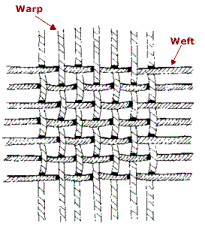
The buzz about “single ply” in the last five years or so, was a reaction to customers feeling cheated by the concept of 2 ply (meaning a 300 thread count construction made with 2 ply yarns and called a 600 thead count). But the “single ply” concept has its own problems, as stated above. Sheets made with “single ply” yarns but with 6 to 8 picks do not necessarily result in the best feeling or highest quality weave &emdash; but they do achieve the higher thread count in a way deemed more correct by international standards and the FTC.
In a quality product, the incremental comfort value of thread counts over 300 is very little. A 300 thread count can feel far superior to a 1000 thread count. Thread count has become a simple metric used by marketing people to capture interest and impress with high numbers. The problem with mass produced high thread count sheets is that to keep the price down, important elements of quality must be sacrificed, meaning in the end the customer gets a product with an impressive thread count but that probably feels no better (or even worse) than something with a lower thread count.
How does this happen?
- Weaving with 2 ply yarns that do not have a high enough yarn size so the end product feels heavy and blanket-like.
- Inserting multiple yarn threads (picks) into the weft. These are often visible to the naked eye. We’ve heard of as many as 8. This practice increases the thread count but otherwise really has no practical or useful purpose. Depending on the number of picks and yarn size used it can also make the product feel heavy.
There is no simple answer to the thread count, ply and pick game; there are thousands of combinations that will make a beautiful product. We’ve seen excellent examples of every type of construcion (thanks to quality fiber, yarn size and finishing). Keep in mind that with higher thread counts, price and quality do tend to go hand in hand. An extremely high thread count sheet at a very low price is exactly what it sounds like: too good to be true. This is not to say that you have to spend a small fortune for quality sheets – just don’t fall into the thread count trap. Unfortunately, a lot of companies don’t make it easy to be well informed. At Linenplace, we do our best to present you with all the information you need to find the product that’s right for you. We would like to encourage our customers to focus less on thread count and more on the other quality indicators (fiber quality, yarn size, finishing and construction). We believe you will get a better, more comfortable product that truly represents quality and value.
(Updated Spring 2009)
We receive a lot of questions about fabric, weave, ply, types of cotton, etc… Anything you can think of really. We compiled a list of all of the questions and our answers to them.
Q. What is the best thread count?
A. The best thread count will typically be between 200 and 800 depending on the specific qualities you prefer your bed sheets to have. Generally, the higher the thread count of the sheets, the softer they will be.
Q. What are the most comfortable bed sheets?
A. The most comfortable bed sheets are usually made from 100% cotton with a thread count of around 600-800. What you find the most comfortable may not be to someone else so be prepared to try a few different kinds if you are not super happy with your first choice.
Q. What is the softest bed sheets made of?
A. The softest bed sheets are usually made of Sateen, a type of premium cotton made with a satin weave that gives the sheets a very lustrous, soft feel.
Q. What are Egyptian cotton sheets?
A. Egyptian cotton sheets are considered the best of the best. They are made from two types of long-fibered cotton that is also called ELS or extra-long staple. It creates a soft, luxurious sheet that gets softer with age. They are very popular in upscale hotels.
Q. What are percale bed sheets?
A. Percale refers to a type of weave that is used to produce these popular sheets which is a flat, closely woven weave that is very tight and crisp. Percale sheets are finer than muslin and usually range in thread count from 180-300. They have a crisp, cool feeling that is very popular among consumers.
Q. What does the thread count in sheets mean?
A. The term thread count refers to the number of vertical and horizontal threads per square inch of the fabric.
Q. Is a higher thread count better?
A. Not necessarily. Once you go above 600 to 800 thread counts, the numbers start to become irrelevant in terms of better. The most popular thread count seems to be in the 400-600 range. Super high thread count sheets tend to be less durable and can tear and wear out a lot quicker also.
Q. What is a sateen sheet?
A. A sateen sheet is a sheet made from 100% cotton that has a higher thread count and is woven in a particular manner. Sateen sheets typically have a sheen to them and are woven from long-fiber or combed cotton threads that are soaked in lye and then acid which strengthens the cotton fibers and gives them more durability. It also gives them the signature sheen that sateen sheets have.
Q. What is a bamboo sheet?
A. Bamboo is a material that is becoming increasingly popular for bedding. It is sustainable, has natural antimicrobial properties, is softer than linen and cotton, and absorbs moisture as well. It is becoming more well-known due to one of the appealing features bamboo sheets have of keeping you cool in the summer and warm in the winter.
Q. Is a 1500 thread count good?
A. A higher thread count does not automatically mean a higher quality sheet. The material the sheet is made of and the type of weave that is used will make more of an impact when it comes to quality and comfort. Beware of manufacturers that artificially inflate thread count to command a higher price for the sheets. The most popular and comfortable thread count is usually in the 400-800 range.
Q. Is thread count important?
A. Thread count is not as important as some manufacturers would want consumers to believe it is. What determines the quality and comfort of bed sheets the most is the quality and type of the materials used in creating the sheets. Just because a sheet set claims to have a high thread count doesn’t mean that you will automatically have high quality, comfortable sheets.
Q. Is Egyptian cotton better?
A. Yes. It is the fibers used in the creation of a sheet that determines its quality. Egyptian cotton fibers are considered to be the best due to their softness, length of the fibers and the fiber strength. Longer fibers make it easier to have a higher thread count and also make the fabric stronger.
Q. Is Pima cotton good?
A. Pima or Supima as it is also called is very similar to Egyptian cotton in quality. In fact, the only real difference is where it comes from. Pima cotton comes from the Southwest United States and Egyptian cotton is grown and harvested along the Nile River.
Q. What is the difference between percale and sateen?
A. The difference between these two is the weave used to create them. Percale bed sheets have a plain weave and have a matte finish and are described as crisp. It is more breathable and lighter in weight than sateen which makes them great for summertime and warmer climates. Sateen is woven in a way that creates a smooth, silky finish that has an appealing sheen to it. Sateen sheets are known for this luster and the way they hang.
Q. Do percale sheets wrinkle?
A. The density of threads that Percale sheets contain can cause the sheets to wrinkle more frequently if the thread count is higher than 400. Lower thread counts than 400 may not wrinkle as much but you may sacrifice comfort.
Q. What is the thread count of a fabric?
A. The thread count of a fabric indicates how many horizontal and vertical threads are woven into one square inch of the fabric.
Q. What is a good thread count for a duvet cover?
A. A thread count of 300 or more is good for a duvet cover
Q. What is a damask sheet?
A. Damask sheets have patterns that are made by different fabric textures. Many damask sheets are striped but rather than using two different colors the stripes are made by alternating to different kinds of weaves, typically a shinier weave and a matte weave so there is contrast. The majority of damask sheets have simpler patterns including stripes, polka-dots, and checkers.
Q. Is thread count 180 good?
A. 180 thread count bed sheets are considered good quality and make great sheets for a child’s bedroom. It is a step above a basic, functional bed sheet set with a thread count of 150.
Q. What is cotton sateen fabric?
A. Sateen fabric is made using a special satin weave and is made from spun yards rather than a filament. The signature sheen and soft feel of sateen fabric comes from the satin weave structure.
Q. How do you wash sateen sheets?
A. Wash sateen sheets in a separate load than the regular laundry so buttons or zippers won’t damage the fabric. Use the gentle cycle and cold water along with a mild laundry detergent.
Q. Are bamboo sheets better than Egyptian cotton?
A. This is really more about what you prefer in a sheet. Egyptian cotton is breathable and absorbs moisture from the body. It is also durable and very soft. One of the appeals of Egyptian cotton is that it gets softer the more you use and wash it. Bamboo sheets are more breathable than cotton and have the ability to wick moisture away from the body without sticking to the skin even in super-hot temperatures. It also has natural antibacterial properties making them a great choice for those with allergies. So while there is no clear answer as to which is best, there will be one that is a better fit for your specific needs.
Q. What is the highest thread count for bamboo sheets?
A. Bamboo sheets are very eco-friendly but it is also very soft. Most bamboo sheets that are sold to consumers are between 250 and 350 thread counts. Even this lower count will be softer and feel better than other types of sheets with higher thread counts. Anything over 350 is really unnecessary in a bamboo bed sheet and just runs the price up.
Q. What is the meaning of combed cotton?
A. Combed cotton is cotton that has gone through a special process that makes the fabric stronger, softer and even better feeling. During the production process the fibers of the cotton are literally combed with extremely fine brushes so only the straightest, longest, and strongest fibers are left. This process also gets rid of any impurities that are remaining after the seeds and dirt are removed in the first step.
Q. What is Egyptian quality cotton?
A. This is cotton that has the longest, finest staple of all the cotton fabrics. It is considered the best cotton available that produces the softest, most comfortable and most sought after bed sheets, towels, and other linens.
Q. What is the difference between Egyptian cotton and cotton?
A. Egyptian Cotton and regular cotton come from entirely different plants so the properties of each are different. The process in which Egyptian Cotton is harvested is also different to ensure that the fibers remain straight, unstressed, and intact. The longer fibers allow for finer yarns to be made which produces softer, stronger cotton. Regular cotton is still liked by many consumers, but it is not as soft and has more splices in it which happens from being harvested by machines.
Q. Why is Egyptian cotton so special?
A. There are several reasons that Egyptian cotton is special. This includes the special place it grows (Along the Nile River), how it is harvested (by hand) and the ability it has to create extra-long fibers. These extra-long fibers produce yarns that are thinner than regular cotton due to the longer length they have. It is also smaller in diameter but surprisingly it is stronger than other types of cotton. The smaller yarn allows for there to be more threads per sq. in. This creates lighter weight material that breathes well and that is stronger and softer than other cotton.
Q. What is combed yarn?
A. Fibers that have been laid parallel and combed with fine brushes that won’t damage the fibers.
Q. What is carded yarn?
A. Carding is another process in which cotton is prepared to be used. Carded cotton is a little fuzzier than combed cotton due to the process which can either be done by hand or by machine. Machine carding will be a little less smooth.
Q. What is viscose from bamboo?
A. It is cellulose that comes from the bamboo plant and is typically used to make Rayon.
Q. How are sheets made from bamboo?
A. Bamboo is either processed chemically or mechanically to crush the woody parts of the plant and then natural enzymes are used to break down the walls of the bamboo into a big mass of mush so the natural fibers can be combed out and then spun into threads. These threads are then used to produce bamboo bed sheets and other bamboo linens as well.
Q. What is a Tencel sheet?
A. Tencel is a brand name of a special fiber called Lyocell. This is a type of rayon that is made from cellulose, most often from renewable sources. It is an eco-friendly option for those looking for those features. Tencel sheets are very soft, wick away moisture to keep the body cool and have antimicrobial properties as well.
Q. Is rayon from bamboo?
A. Rayon comes from regenerated cellulose fiber. The regenerated cellulose fiber is converted from a natural material that is raw and goes through a chemical process. Rayon can be created from the cellulose of wood, bamboo, cotton fiber, or paper.
Q. Can you use fabric softener on Egyptian cotton sheets?
A. No, fabric softener should never be used on Egyptian cotton sheets due to the conditioners it contains that can damage the fibers.
Q. How do you wash 100% cotton sheets?
A. Wash your 100% cotton sheets before you put them on the bed. Place them in the washing machine after removing the packaging. Pour in 1 cup of baking soda and wash in warm water (not hot) on a regular cycle but do not use detergent. Add 1 cup of white vinegar to the rinse cycle and reset the temperature to cold.
Q. What is combed cotton sateen?
A. Combed cotton sateen are made from 100% cotton that has a higher thread count and a luxurious sheen. It is usually made from combed cotton or can be made from carded or long-fiber cotton as well. The special process that produces the sheen and softness involves the threads being soaked in lye and then in acid.
Q. What is cotton satin fabric?
A. Cotton satin fabric has a luster that is similar to satin. It is soft to the touch and drapes beautifully on the bed. The special soaking baths in lye and acid that cotton satin goes through is what gives it strength as well as its pretty luster.
Q. What is Pima cotton?
A. Pima cotton is also called ELS cotton or extra-long staple. It is grown in Peru, Australia, and the southwestern US. It is extremely absorbent and durable and has long fibers that are similar to those found in Egyptian cotton.
Q. What are the most comfortable bed sheets?
A. There will be many different answers to this question due to the fact that people have different preferences. The most comfortable bed sheets are the ones that you like the best that meet your needs whether it is to stay cool and dry or you want something that is super soft. Decide what your specific preferences are and go from there.
Q. Is linen soft?
A. Yes, vintage linen is very soft and is very hard to replicate commercially with a mechanical process. It is durable and has a lot of benefits that make it a popular fabric.
Q. How do you keep a duvet cover in place?
A. Turn the duvet cover inside out and attach two 5” long pieces of fabric tape to all four corners. Once that is done, tie the fabric tape around each corner of the comforter.
Q. What is 60s cotton?
A. 60s cotton is a fabric with a certain thickness. Cotton comes in 4 thicknesses, 20s, 40s, 60s, and 80s. The measurement is determined by taking 1 pound of the thread and dividing the length of the thread by 840 yards.
Q. What does 500 thread count mean?
A. This means that there are 500 threads per square inch of fabric, 250 warp (lengthwise) and 250 weft (widthwise)
Q. What is cotton percale?
A. Cotton percale is a flat, smooth fabric that is closely woven and combed. It can come in 100% cotton or a blend of cotton/poly (usually 50/50). Thread counts usually range from 180 to 200.
Q. Are percale sheets soft?
A. Crisp is a better description of a percale sheet. They may get softer over time with multiple washes but these sheets typically feel cool and crisp against your skin making them very popular in the summertime.
Q. How do hotels keep sheets from wrinkling?
A. Lightly spritz the top of the sheet before making the bed. (lightly, you don’t want it soaked) the spritzing will relax the creases and wrinkles and then you can make the bed tightly for a neat, crisp look.
Q. What is Turkish cotton?
A. Turkish cotton is grown in the Aegean Region. It is long-fiber cotton that becomes even fluffier, more absorbent and softer the more you wash it.
Q. What does 1800 Series mean?
A. the 1800 series refers to thread count for the sheets in the line.
Q. Is a 500 thread count good?
A. The most popular thread count with consumers tends to be between 400-800. 500 thread count fits right in the middle of that range. Remember not to ONLY look at thread count when choosing your bed sheets. The quality and type of the material will play a larger part in how comfortable and enjoyable your bed sheets are to sleep on.
For the fabric’s color: Please send us your cutting sample, or inform us the Pantone Color Number; or refer to our color number and choose it for your fabrics. Based on your choice or request, we can make lab-dips color for your approval, and then dye the mass fabrics.
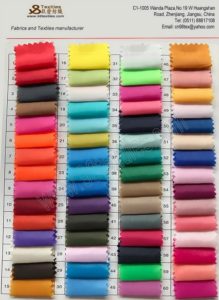
We can weave fabrics with permanent fire-resistant yarns, or post-finish various fabrics with fireproof, such as fireproof polyester satin fabrics, Voile fabrics, Blackout Fabric, and so on. Our flame retardant fabrics achieve standard of EN13773 1-Class, or BS5867, or NFPA 701.
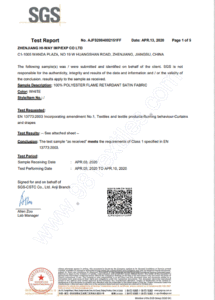
We can weave fabrics with permanent fire-resistant yarns, or post-finish various fabrics with fireproof, such as fireproof polyester satin fabrics, Voile fabrics, Blackout Fabric, and other polyester fabrics. Our flame retardant fabrics achieve standard of EN13773 1-Class, or BS5867, or NFPA 701.
